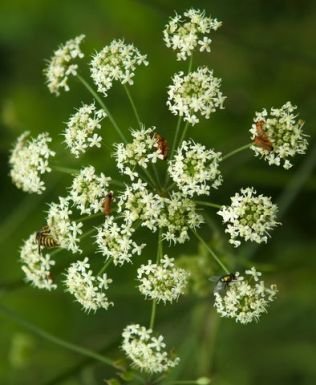Poison Hemlock
Poison Hemlock (Conium maculatum)
This weed is native to various regions of Europe, West Asia and North Africa. It was brought to the United States as an ornamental plant in the 1800's and is now found, with exception, throughout the U.S. It is abundantly found along the west coasts of both the U.S and Canada.
|
Conium maculatum is from the Umbelliferae family, which includes parsley and carrots. It is often confused with the weed Queen Anne's Lace (Daucus carota), of the Apiaceae family. Unlike parsley, carrots and Queen Anne's Lace (which is an edible wild carrot) this hemlock is poisonous as it's name states. |

|
Poison hemlock is an herbaceous biennial herb. Herbaceous plants are those that die at the end of growing season but can come back in spring.
In it's 1st year:
Weed forms a lacy, feathery, fern-like rosette of leaves in early spring. Leaves are shiny green and triangular and grow anywhere from 1 to 16 inches.
In late spring white flower umbels begin to show, whereas Queen Ann's Lace flowers appear late summer. An umbel is a flat-topped, rounded flower cluster, composed of small flowerets growing off small individual stalks which are all attached to one large stalk - like an umbrella.
In it's 2nd year:
Stalks grow in height anywhere from 3-8 feet, sometimes higher, and 1/2-1 inch thick. Stalks are smooth, hollow, upright and branched with ridges that usually have purple blotches.
Queen Anne's Lace grows up to 3 feet tall, has hairy stems with toothed leaves that alternate.
All parts of this weed are extremely poisonous, especially the white, fleshy roots and light brown seeds. The poison is a clear liquid alkaloid, coniine, which creates the musky, rotten egg odor when plant is crushed.
Any animal that ingests this weed dies within a few hours. Symptoms include heavy salivation, burning sensation in mouth, nausea, vomiting and diarrhea. With irritation to mucous membranes, eventually one will show various neurological signs from which the ultimate death results from asphyxia. One can also be burned by touching weed.
Poison hemlock reproduces solely by seed and is very invasive. It grows easily and prefers fertile, moist soils but can also grow in gravelly to loamy soils. It is found in many diverse settings such as grazing areas to waste and woody areas.
-
If removing manually it is important to wear protective clothing. This includes gloves and long sleeves.
Don't get juices from weed in cuts, mouth or eyes.
Different options for removing manually include:
- Cut down area where weed is growing and cover for a growing season with a solarizing black plastic mulch.
- Because this is a biennial, the entire root system does not need to be removed. Repeated mowings will deplete energy reserves in the taproot.
- Hand pulling weeds works effectively but remember the roots are especially poisonous. If determined to pull, wait until soil is wet for better results.
-
If attempting to use a pre-emergent herbicide consider where the weed is growing. Because it prefers moist habitats, preemergents may be ineffective. Post-emergent herbicides, such as glyphosates, are the best options for chemical use. Always dispose of weed -
do not put it in compost.
Don't burn this weed! This would release toxins in the air.
FYI:
- It has been found that large, invasive infestations of poison hemlock are depleted by releasing the Defoliationg Hemlock Moth (Agonopterix alstremeriana). This is the only known host plant to the European moth.
- "Conium" is Greek and means "to whirl", referring to the vertigo one may feel upon ingestion.
- Historically the philosopher Socrates was executed by being forced to drink poison hemlock juice in 399 BC.
- Black Swallowtails enjoy feeding on the flowers of this weed.
- Another weed that many confuse Poison Hemlock with is Water Hemlock (Cicuta spp.) of the Apiaceae family (same family as Queen Anns Lace family).
Both Poison and Water Hemlock are poisonous weeds. Water hemlock is a perennial weed that can also be found growing in moist habitats like drainage ditches, marshes and around fresh water.
Like Conium maculatum, Water Hemlock has compound leaves, which is a leaf composed of many leaflets sharing one common stalk. Flowers are small whitish-green umbels and the stalks are large and tuberous as well.
Related Articles:
Don't forget about these options for weed control.
Back from Poison Hemlock to Weed Identification
Back from Poison Hemlock to Easy Butterfly Garden.com
 Copyright © 2010-2022 Easy-Butterfly-Garden.com
Copyright © 2010-2022 Easy-Butterfly-Garden.com
Privacy Policy Disclaimer

Join Easy Butterfly Garden on Facebook
Recent Articles
-
Annual Bluegrass
Jan 14, 17 08:14 PM
Annual bluegrass (Poa annua) is considered a weed in the Poa family, which has a few popular turf grasses. If this gets into your butterfly garden listed are a few ways to eradicate it.
-
Candytuft Flowers
Sep 25, 16 10:54 PM
There are the annual, or Iberis, candytuft flowers and also perennials which are called Iberis sempervirens.
-
Keeping Deer Out
Sep 19, 16 01:10 PM
Reviewing the types of products available for keeping deer out of our gardens along with building fences. Many of these products help with other garden pests.
-
Butterfly Meadows
Sep 19, 16 12:52 PM
Compared to other wildlife gardening, butterfly meadows take time and are not for the faint of heart.
-
Natural Gardening
Sep 19, 16 12:32 PM
Natural gardening includes different types of gardens. These garden types create a casual, natural envirionment and help sustain native wildlife which includes butterflies.






New! Comments
Have your say about what you just read! Leave me a comment in the box below.